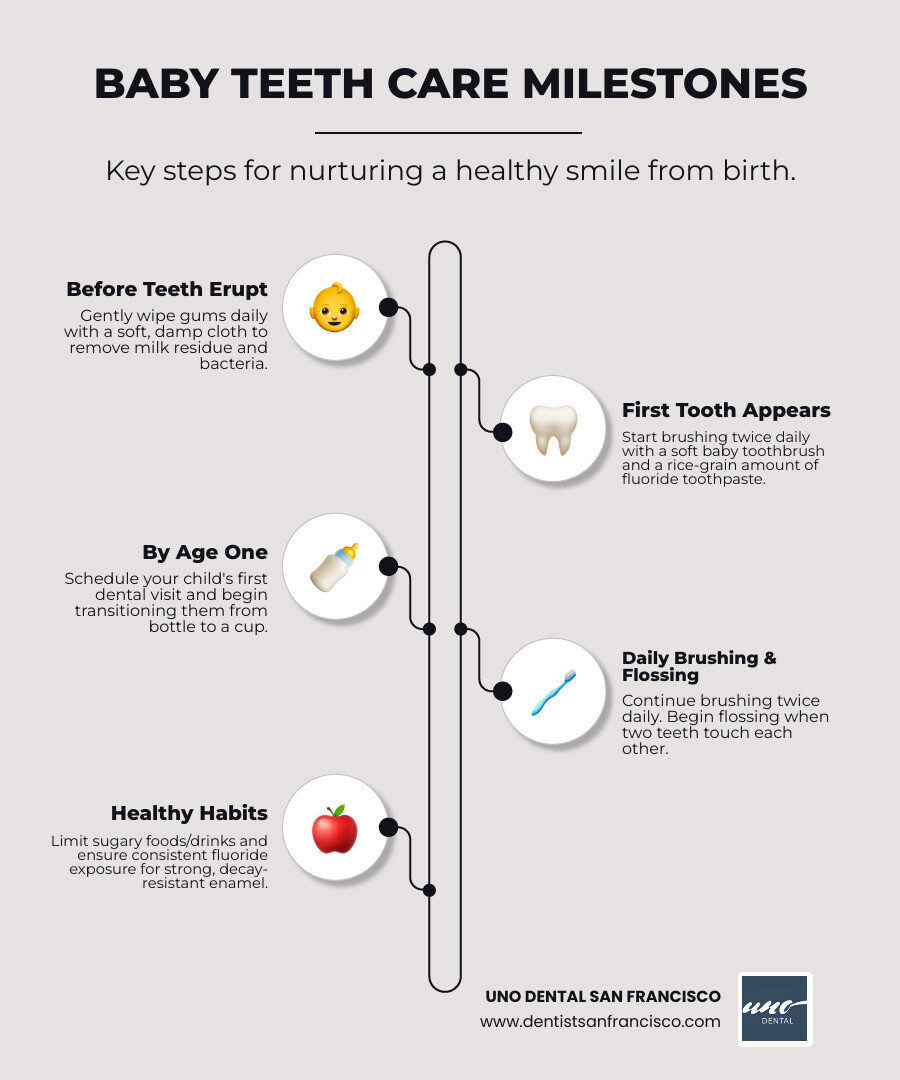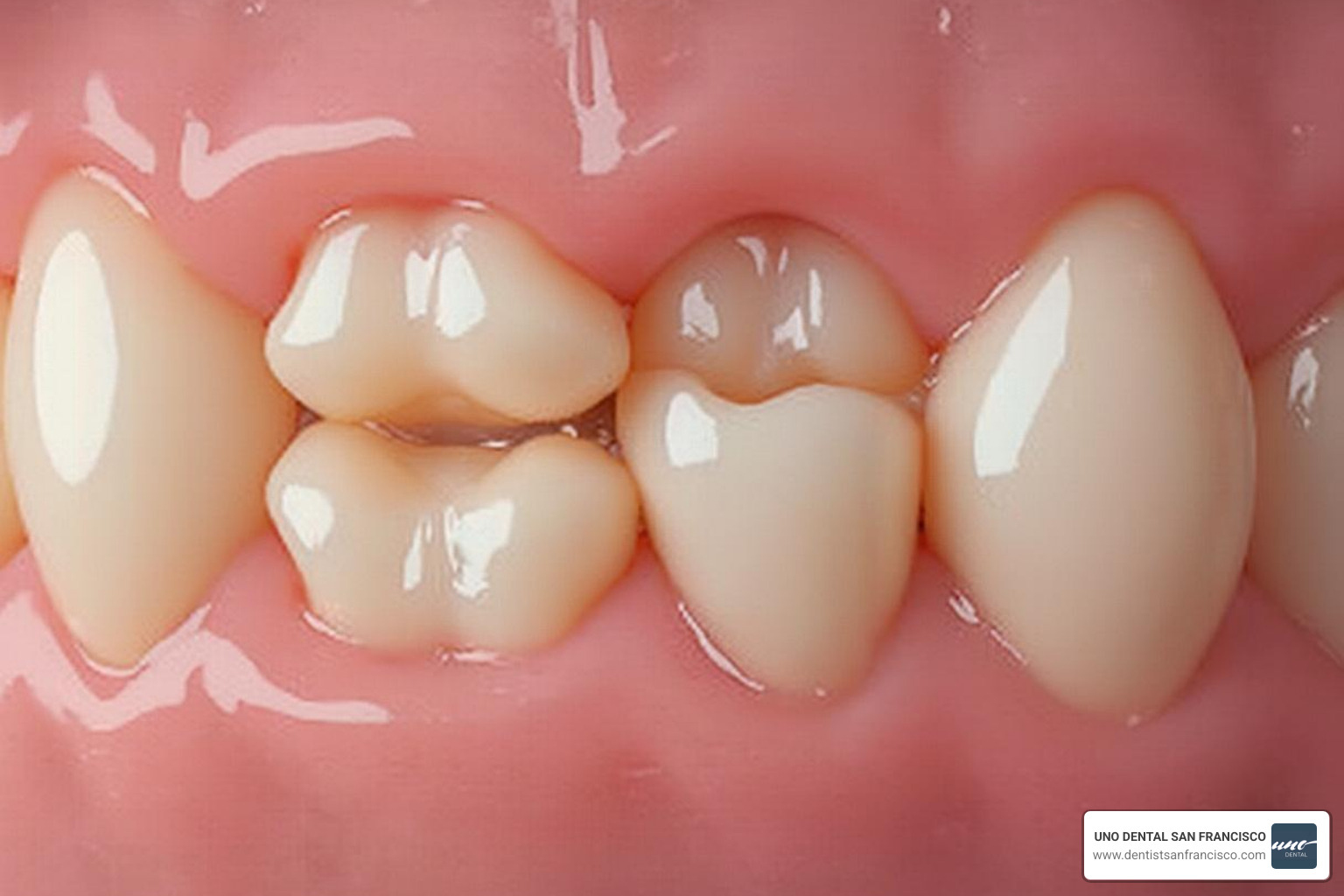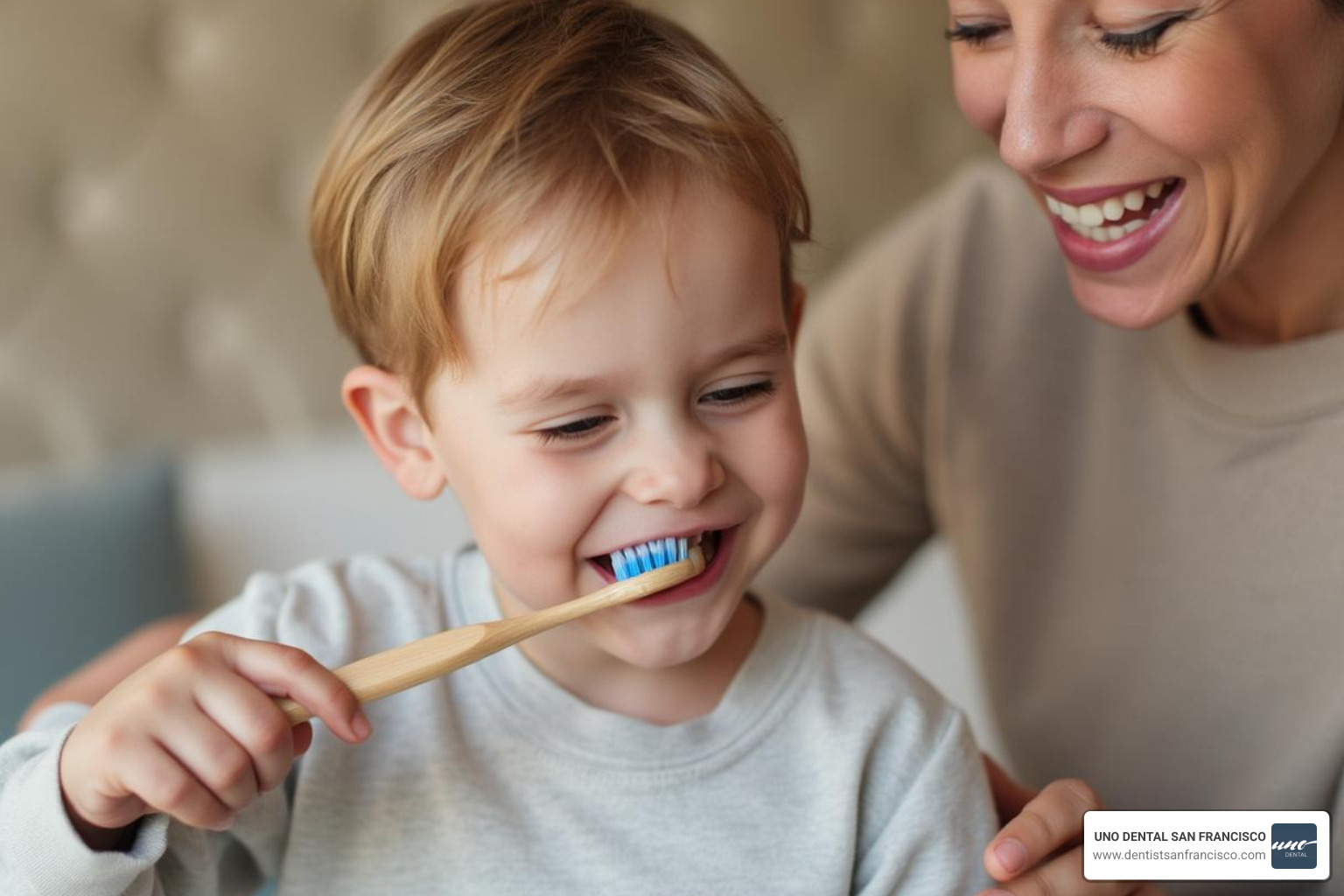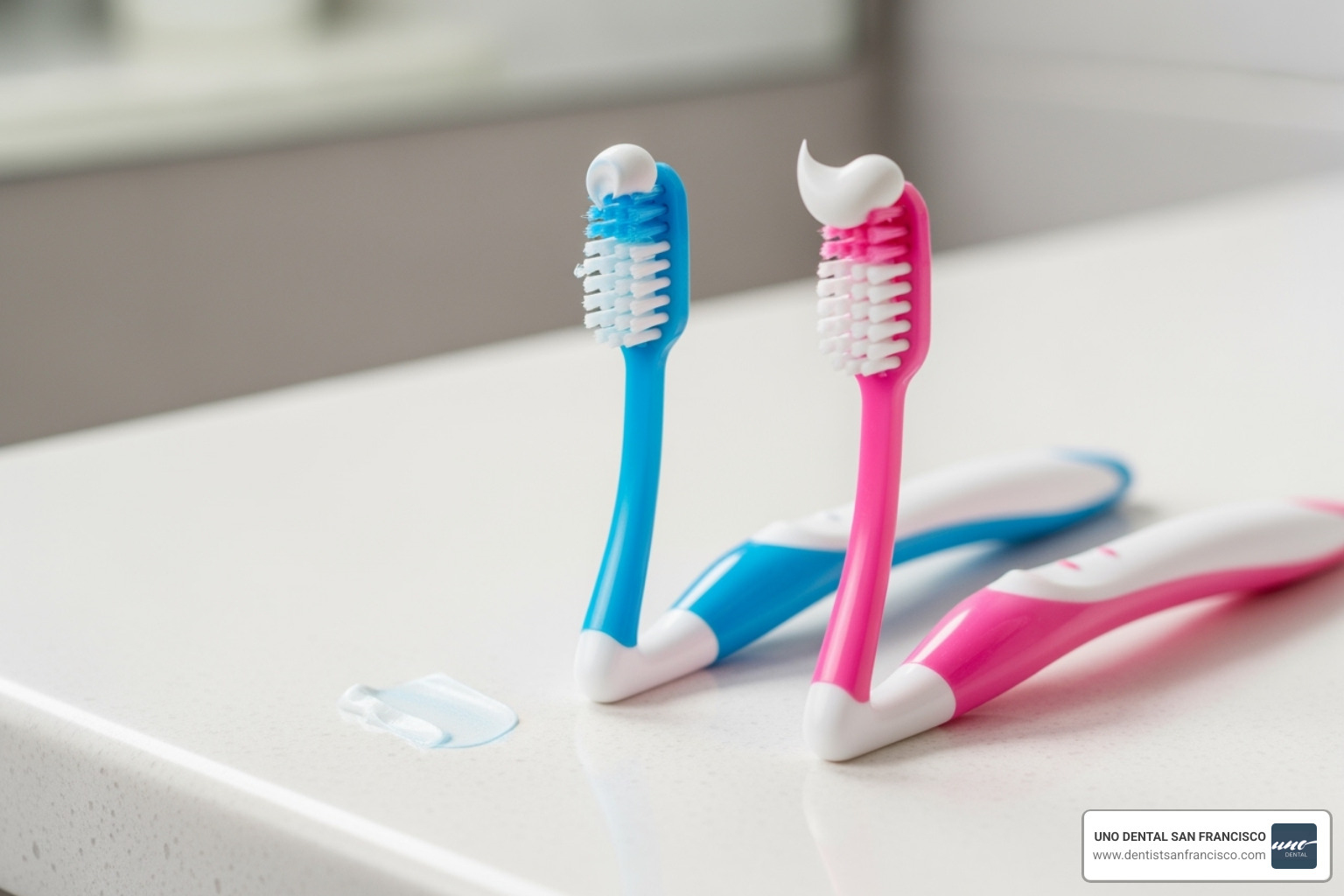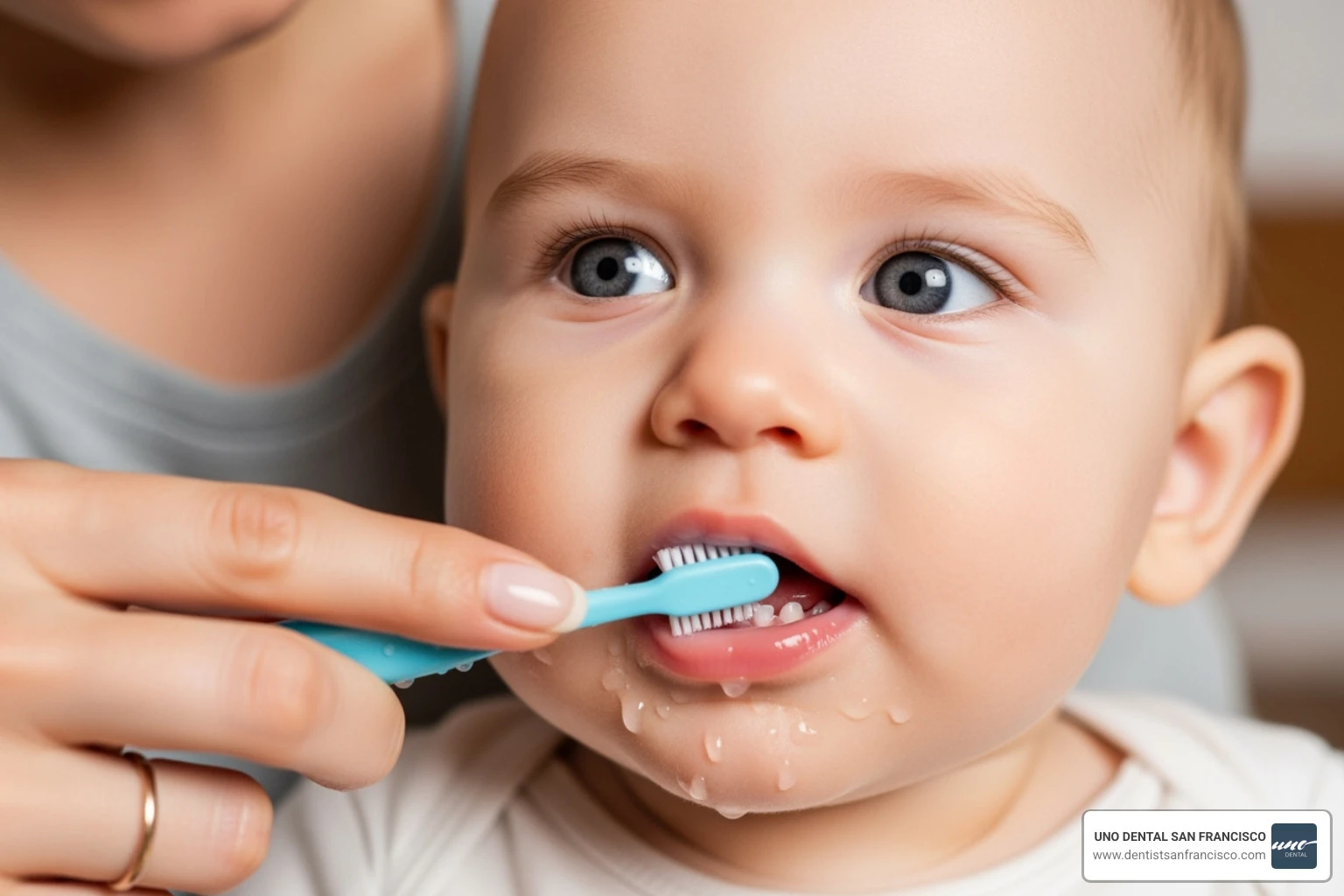
Why Early Baby Teeth Care Matters
Seeing your baby's first tooth is an exciting milestone! But did you know that cavities can develop as soon as your baby has teeth? Proper baby teeth care is vital, not just for a healthy smile now, but for lifelong dental well-being.
For effective baby teeth care, remember these key steps:
- Start early: Clean gums even before teeth appear with a soft, damp cloth.
- Brush when first tooth emerges: Use a soft baby toothbrush and a tiny smear of fluoride toothpaste (rice-grain size).
- Prioritize fluoride: It strengthens enamel and fights decay.
- Visit the dentist early: Schedule the first visit by age one or when the first tooth appears.
- Limit sugar: Avoid sugary drinks and bedtime bottles.
This guide will show you how to protect your little one's smile from day one. You'll learn simple, actionable steps to prevent common issues like tooth decay and establish habits for a lifetime of healthy teeth.
As a leader in advanced dentistry, Dr. Aghiad Kandar, DDS, brings over 15 years of experience to UNO DENTAL SAN FRANCISCO. His expertise in baby teeth care allows him to guide parents effectively, setting children up for a lifetime of happy, healthy smiles.
Common baby teeth care vocab:
The Foundation: Why Baby Teeth Matter and When They Appear
It's easy to wonder why we fuss so much over tiny teeth that are just going to fall out anyway, right? It might seem like a lot of effort for something temporary. But here's a little secret: those adorable baby teeth are actually incredibly important! They're like little superstars in your child's developing mouth, playing many vital roles for their health and happiness.
First off, healthy baby teeth are super important for chewing food properly. This isn't just about enjoying snacks; it's the very first step in digestion, making sure your little one gets all the good nutrients they need to grow big and strong. They also play a big part in how your child learns to speak clearly. Without a full set of healthy primary teeth, kids can sometimes struggle to make certain sounds, which can affect how they communicate and connect with others.
Beyond these practical jobs, baby teeth help shape your child's facial structure. And let's not forget about confidence! A bright, healthy smile can give a child a huge boost, helping them make friends, feel good at school, and simply enjoy life more. Good baby teeth care sets the stage for all of this.
Perhaps their most crucial role is acting as "nature's braces." Think of each baby tooth as a personal placeholder, holding the perfect spot in the jaw for the permanent adult tooth that will come in later. Each baby tooth essentially reserves a prime piece of real estate for its adult successor. If a baby tooth is lost too early, perhaps due to decay or injury, the teeth next to it can start to drift into that empty space. This can lead to crowding and alignment problems for the permanent teeth trying to erupt, often meaning more orthodontic work down the road. That's why keeping these primary teeth healthy and cavity-free is such an important part of baby teeth care. It also saves your child from the pain and discomfort of a decayed tooth needing treatment or removal.
When to Expect the First Tooth
The arrival of your baby's first tooth is a truly exciting milestone for any parent! Most babies will get their first tooth sometime between 6 and 12 months of age. Some little eager beavers might show a tooth as early as 3 months, while others might take their time, not getting one until 12 or even 14 months. Every child's development is unique, so try not to worry too much about exact timelines.
Typically, the first teeth to make their grand entrance are the lower central incisors (those two cute bottom front teeth), followed by their counterparts on the top. By the time your child is around 3 years old, they should have a full set of 20 primary (baby) teeth—10 in the top jaw and 10 in the bottom. These little pearly whites will serve them well until they naturally start losing baby teeth between the ages of 5 and 12 years. The front teeth usually fall out first, between 5 and 8 years old, while the back teeth, which do most of the chewing, might not fall out until your child is 10 to 12 years old.
The Role of Baby Teeth in Future Dental Health
As we've touched on, baby teeth are much more than just temporary visitors; they are the absolute foundation for your child's lifelong dental health. Their proper position and health gently guide the permanent teeth into place, helping to prevent future crowding and misaligned bites. The health of these primary teeth directly affects the health and alignment of the permanent teeth that are developing right underneath them.
If baby teeth suffer from untreated decay, it can lead to pain, infection, and even damage to the developing adult teeth below. A decayed baby tooth might need to be extracted, which can be a painful and scary experience for a child. Plus, if a baby tooth is lost too early, the teeth next to it can start to drift into the empty space, leaving insufficient room for the permanent tooth to erupt properly. This often means that orthodontic treatment (like braces) will be needed later in life.
At UNO DENTAL SAN FRANCISCO, we truly understand this critical link between the health of baby teeth and a lifetime of healthy smiles. We are dedicated to providing the comprehensive baby teeth care and guidance needed to ensure your child's smile develops beautifully. Find out more about how we can support your family's dental journey by exploring more info about our comprehensive dental services.
Soothing Teething Pains and Caring for Gums
Before those first tiny teeth even make their grand debut, your baby's gums are already a hub of activity. That's why proper gum care is a crucial first step in baby teeth care, even before you see any pearly whites. Starting from birth, we recommend gently wiping your baby's gums with a clean, damp washcloth or a piece of moist gauze at least twice a day. Doing this, especially after feedings and before bedtime, helps clear away any lingering bacteria and sets a wonderful routine that will make brushing a breeze later on.
Then comes the exciting (and sometimes challenging!) phase of teething. It's a completely natural part of your baby's development, though it can bring some discomfort. Teething usually kicks off between four to seven months of age, but some little ones might start showing signs as early as three months. You'll likely notice increased drooling, fussiness, irritability, an irresistible urge to chew on everything, and gums that look a bit swollen or tender.
When your baby is feeling those first toothy aches, safe soothing methods are key. Offering a clean, chilled teething ring or a cold, moist washcloth for them to gnaw on can provide wonderful relief. The coolness helps to numb the gums and ease the discomfort. Gently rubbing your baby's gums with a clean finger can also be incredibly comforting – the pressure often helps counteract the ache. A clean, moist gauze pad wrapped around your finger can work wonders for a gentle gum massage too.
However, there are certain methods and products we strongly advise against due to significant safety concerns. The FDA has issued clear warnings against using topical pain relievers containing benzocaine for teething, as they can cause serious, even life-threatening, side effects. Similarly, homeopathic teething gels or tablets containing belladonna have been linked to severe health problems. While popular, amber teething necklaces pose serious strangulation and choking risks and have no proven effectiveness for soothing teething pain. Always prioritize your baby's safety and consult with your pediatrician or dentist before using any over-the-counter medications or remedies. You can find more information from the FDA regarding these warnings here.
Safe Ways to Soothe a Teething Baby
When your little one is struggling with teething discomfort, there are several tried-and-true methods that are both safe and effective. Beyond the chilled items and gentle gum rubs, consider offering a clean, solid rubber teether (always avoid liquid-filled ones, which can break and leak). A chilled spoon can also be a surprisingly soothing object for them to gnaw on.
If your baby is particularly uncomfortable and nothing else seems to help, your pediatrician might suggest a weight-appropriate dose of acetaminophen (like Tylenol) or ibuprofen (like Advil or Motrin). Always check with your pediatrician first for the right dosage and to make sure it's suitable for your baby. And please, never give aspirin to children due to the risk of Reye's syndrome.
Teething Myths vs. Facts
It's easy to get caught up in old wives' tales about teething, but it's important to separate fact from fiction for your baby's health and your peace of mind. Let's clear up some common misconceptions:
- Myth: Teething causes fever.
- Fact: While a slight temperature rise can happen when your baby is teething, a true fever (a temperature over 100.4 degrees Fahrenheit or 38 degrees Celsius) is generally not caused by teething. If your baby has a true fever, it's typically a sign of an illness or infection that might need treatment, not just a new tooth coming in.
- Myth: Teething causes diarrhea or rashes.
- Fact: Just like fever, diarrhea and rashes are not normal symptoms for a teething baby. If these occur, especially alongside a fever, it's definitely a good idea to call your pediatrician.
For more detailed insights into what real science says about teething symptoms, you can check out this scientific research on teething symptoms.
Always remember that if your baby is experiencing significant discomfort, a high fever, diarrhea, or any other concerning symptoms, it's best to contact your pediatrician. We want to ensure your baby is comfortable and healthy, and that means addressing any potential underlying issues promptly.
The Ultimate Guide to Baby Teeth Care and Brushing
Okay, so those tiny teeth have made their grand appearance! Now comes the fun part – establishing a fantastic brushing routine. This is truly the cornerstone of effective baby teeth care. Think of it as a little dance you do together, twice a day: once in the morning to start the day fresh, and especially right before bedtime. That evening brush is super important because when your little one sleeps, saliva flow decreases, leaving those precious teeth a bit more vulnerable to sneaky decay.
Aim for two minutes of brushing each time. We know, two minutes might feel like an eternity when you have a squirming toddler! But there are tricks to make it fun. Try putting on a favorite song that lasts two minutes, setting a fun timer, or even brushing your own teeth at the same time to show them how it's done. The goal is to make it a positive, playful experience, not a battle.
Tiny hands aren't quite ready for this big job yet. Young children simply don't have the fine motor skills to clean their own teeth effectively. So, parents, you're the designated brushers for quite a while! We generally suggest that an adult should be the main brusher until a child is around 8 years old. A good rule of thumb? When they can write their name well, they might be ready to take over with supervision.
How to Brush: A Step-by-Step Guide to Baby Teeth Care
Ready to become a brushing pro? Here’s your simple guide:
- Choose the Right Tools: First things first, grab an infant toothbrush. These are designed specifically for tiny mouths, with a small head and super soft bristles that are gentle on delicate gums.
- Finding Your Brushing Sweet Spot: Comfort is key for both of you! You can sit your baby on your knee with their head resting gently against your chest, or lay them down comfortably where you can clearly see all their little teeth.
- The Brushing Ballet: Hold the toothbrush at a slight angle to their teeth. Now, use gentle, circular motions to clean every single surface of every tooth. Think of it like a tiny dance around each tooth. Avoid scrubbing back and forth, as this can be too harsh. Make sure you get the outer surfaces, the inner surfaces (facing the tongue), and the chewing surfaces.
- Don't Forget the Unsung Hero: The Tongue! Gently brush your baby's tongue too. This helps remove bacteria and keeps their breath fresh.
- The Great Spit-or-Rinse Debate: Once your child is old enough to understand and is able to spit (usually around age 2), teach them to spit out the excess toothpaste. Here's a little secret: there's no need to rinse with water afterward! Letting a tiny bit of toothpaste linger allows the fluoride to keep working its magic, protecting their teeth even after you're done brushing. For very young children who can't spit yet, don't worry – the small amount of fluoride toothpaste we recommend (more on that below!) is perfectly safe to swallow.
Choosing the Right Toothpaste: A Parent's Guide to Baby Teeth Care
Selecting the correct toothpaste is a crucial part of effective baby teeth care. Our top recommendation? Use a fluoride toothpaste. Think of fluoride as a tiny superhero for their teeth! It’s a natural mineral that strengthens tooth enamel and can even help heal early signs of decay.
When you're shopping for toothpaste, look for one that proudly displays the American Dental Association's (ADA) Seal of Acceptance. This means it's been tested and meets strict criteria for safety and effectiveness.
Now, for the big question: how much toothpaste? The amount is super important and changes as your child grows:
- For children younger than 3 years: You only need a tiny smear of fluoride toothpaste, no bigger than a single grain of rice. Seriously, it's a very small amount, but it packs a powerful punch!
- For children aged 3 to 6 years: At this age, you can upgrade to a pea-sized amount of fluoride toothpaste.
It's super important to supervise your child closely during brushing, especially when they're young. This helps ensure they use the correct amount and don't swallow too much. While using the recommended amounts is incredibly beneficial, swallowing too much toothpaste over time can lead to a condition called dental fluorosis, which might cause some white spots or discoloration on their teeth. We want to balance all the amazing benefits of fluoride with minimal risk!
When and How to Start Flossing
Flossing often gets overlooked for little ones, but it's truly an essential piece of a complete baby teeth care routine! You should begin flossing between your child's teeth daily as soon as two teeth touch each other. This often happens when the back molars arrive, but sometimes even front teeth can touch. Those tiny spaces are perfect hiding places for plaque and food bits that a toothbrush can't reach.
For little mouths, those handy floss picks or pre-threaded flossing tools can be a lifesaver – they're often much easier to maneuver than traditional floss. If you're using traditional floss, take a piece about as long as your child's arm. Gently slide the floss between the teeth, curving it into a "C" shape around the base of each tooth where it meets the gum line. Then, gently wipe the tooth from bottom to top a few times until it feels squeaky clean. Make sure to floss both sides of each tooth, and don't forget those very back molars! As you move from tooth to tooth, unroll a new, clean section of floss to avoid transferring bacteria.
Making flossing a daily habit, just like brushing, will set your child up for a lifetime of excellent oral hygiene. It's a small step that makes a huge difference!
Preventing Cavities: Diet, Habits, and Your Child's First Dental Visit
It might surprise you, but even the tiniest teeth can get cavities! It’s a common thought that baby teeth don’t need much protection since they'll eventually fall out. But as we’ve seen, neglecting baby teeth care can actually lead to big problems down the road.
One of the most common issues we see in infants and toddlers is "baby bottle tooth decay," sometimes called "bottle mouth." This happens when sweet liquids – yes, even milk or formula – stay on your baby's teeth for too long, especially if they fall asleep with a bottle. The sugars literally eat away at the tooth enamel, causing discoloration, tiny pits, and eventually, full-blown cavities.
That's why we really encourage you to avoid putting your baby to bed with anything but water in their bottle. If your little one needs a bottle for comfort at night or nap time, make sure it only contains plain water. The same goes for sippy cups; try not to let your child carry a sippy cup filled with sugary drinks between meals.
And a quick note about pacifiers: please never dip your baby’s pacifier in anything sweet like honey, sugar, or juice. This directly exposes their precious teeth to decay-causing sugars.
Here's another important tip: cavity-causing bacteria can actually transfer from your mouth (or any caregiver's mouth) to your baby's. This can happen if you clean a pacifier in your mouth before giving it to your baby, or if you share spoons and taste their food before offering it. We recommend avoiding these practices to keep those tiny mouths as healthy as possible!
Keep a close eye out for early signs of tooth decay. You might notice white, chalky spots or brown spots on their teeth, or even small pits. If you spot any of these, it’s a good idea to reach out to a dental professional right away.
Diet and Habits to Protect Tiny Teeth
What your child eats and drinks plays a huge role in their baby teeth care. Think of their diet as a shield against cavities!
- Water is Your Best Friend: After 6 months of age, water is truly the best drink for your child when they’re thirsty (besides breast milk). Make tap water, especially if it’s fluoridated, the go-to drink for your whole family.
- Go Easy on Sugar: Try to limit sugary drinks like soda, sweetened teas, or fruit juice. If you offer 100% fruit juice, keep it to no more than 4 ounces a day after 12 months, serve it diluted (one part juice to ten parts water), and only at mealtimes.
- Watch Out for Sticky Foods: Foods that cling to teeth for a long time, like fruit roll-ups, raisins, gummy candies, and even some seemingly healthy snack bars with honey, can be particularly harmful. If your child enjoys these, encourage them to brush or rinse with plain water afterward.
- Transition to Cups: Weaning your baby from a bottle to an open cup by 12 months of age is a crucial step. Starting with a lidless cup between 6 and 9 months helps prevent liquids from pooling around their teeth, which reduces the risk of decay.
- Smart Snacking: Choose healthy snacks like raw, crunchy fruits and vegetables (if appropriate for their age), cheese, or plain yogurt. These are much better options than biscuits, sweets, or highly processed snacks. Did you know that breastfeeding during a child's first year can even help cut their risk of tooth decay in half?
It’s not just how much sugar your child eats, but how often and how long their teeth are exposed to it. Every time your child eats or drinks something sugary, the sugar changes into an acid within minutes, and that acid starts attacking their tooth enamel.
The First Dental Visit: What to Expect
This is one of the most important steps in your baby teeth care journey! We strongly recommend scheduling your child’s first dental visit within 6 months after their first tooth appears, or no later than their first birthday. This early visit is key to establishing a "dental home" for your child – a place where they feel comfortable and cared for.
During this first visit, our friendly team at UNO DENTAL SAN FRANCISCO will:
- Perform a Gentle Check-up: We’ll carefully examine your baby's mouth, teeth, and gums for any early signs of decay or other concerns.
- Discuss Oral Hygiene: We’ll give you hands-on demonstrations of the best brushing techniques for your baby's age and talk about the right type and amount of toothpaste to use.
- Answer Your Questions: This is your perfect chance to ask us anything about your child's diet, pacifier use, thumb-sucking habits, or any other dental worries you might have. No question is too small!
- Assess Fluoride Needs: We’ll discuss your child's fluoride intake from water and toothpaste. We might also recommend a fluoride varnish application, which is a quick, painless treatment that gives their enamel an extra boost of fluoride strength.
- Provide Personalized Advice: We'll offer custom guidance on how to prevent cavities and set your child up for a lifetime of healthy habits.
To make the visit as smooth as possible, consider scheduling morning appointments, as children tend to be more rested and cooperative then. It also helps to talk positively about the dentist beforehand and try to keep any personal anxieties to yourself. We're here to make this a fun and comfortable experience for your little one!
Building this early relationship with a pediatric dentist, or a general dentist who specializes in children's care like us at UNO DENTAL SAN FRANCISCO, truly sets the stage for a lifetime of positive dental experiences and excellent oral health. To take this important step, you can find a local dentist for your baby's first check-up right here with us!
Frequently Asked Questions about Baby Dental Health
As parents, it's natural to have a million questions about your little one's health, and their tiny teeth are no exception! We get a lot of common questions about baby teeth care, and we're always happy to help. Here are some of the most frequent ones we hear:
Why are my baby's teeth coming in crooked?
It can be a bit surprising to see those first little teeth emerge looking a little off-kilter, can't it? It's actually quite common for baby teeth to appear crooked or have gaps between them, especially as they first pop through the gums. Think of it like a puzzle being assembled—the pieces don't always look perfect until they're all in place.
Often, this resolves itself naturally as more teeth come in and your child's jaw continues to grow and develop. Baby teeth are essentially "placeholders," and their initial alignment doesn't always predict how their permanent adult teeth will emerge. However, if you notice significant crowding or misalignment with your baby's teeth, it's always a good idea to bring it up. We can assess their bite and jaw development during their first dental visit and offer personalized guidance. It’s all part of making sure their baby teeth care sets them up for a healthy smile.
Is it safe to use fluoride on baby teeth?
Absolutely! Fluoride is a true superstar when it comes to keeping teeth strong and healthy, and it's completely safe and highly recommended for baby teeth care when used correctly. Think of it as a natural shield for their enamel. This mineral helps make tooth enamel more resistant to the acid attacks that lead to cavities. It can even help reverse very early signs of decay!
For our tiniest patients (younger than 3 years old), we recommend using just a tiny smear of fluoride toothpaste—about the size of a grain of rice. Once your child is between 3 and 6 years old, you can increase that to a pea-sized amount. The key is to supervise brushing closely to ensure they use the correct amount and avoid swallowing too much. Swallowing too much toothpaste over time could lead to a mild condition called fluorosis, which might cause faint white spots on the teeth. Most children get enough fluoride from fluoridated tap water and their toothpaste. If your home's water isn't fluoridated, or if your child is at a higher risk for cavities, we might suggest fluoride varnish applications during their dental visits. These are quick, painless, and very effective!
Can I pass cavity-causing bacteria to my baby?
This is a really interesting question that often surprises parents, but the answer is yes, you can! The bacteria primarily responsible for causing cavities, especially a type called Streptococcus mutans, can actually be transferred from a caregiver's mouth to a baby's.
This usually happens through shared saliva. For instance, if you clean a pacifier by putting it in your mouth before giving it to your baby, or if you share eating utensils (like tasting your baby's food with their spoon), you could be transferring these bacteria. Even blowing on your baby's food to cool it down, or kissing them directly on the mouth, can be a way for these tiny bacteria to travel.
While it's impossible to completely avoid all bacterial transfer (you can't stop giving your baby kisses!), being mindful of these habits can definitely help reduce the risk. And here's a bonus tip: maintaining excellent oral hygiene yourself is one of the best ways to protect your baby's developing teeth. A healthy mouth for you means fewer cavity-causing bacteria to potentially share. It's a wonderful reminder that baby teeth care is truly a family affair!
Conclusion
Wow, you made it! If you've been with us through this guide, you've now got a treasure trove of knowledge to give your little one the best start for their smile. From gently wiping those tiny gums even before teeth pop through, to making brushing an exciting part of the day, and understanding the magic of fluoride – every single step you take in baby teeth care is a lasting gift.
It might seem like a lot of steps, but remember, you're doing so much more than just cleaning teeth that will eventually fall out. You're building a strong foundation for their permanent smile, helping them chew, speak clearly, and even boosting their confidence as they grow. You're equipping your child with healthy habits that will serve them for a lifetime, and that's something truly incredible.
Here at UNO DENTAL SAN FRANCISCO, we truly believe that healthy smiles start from day one. We're not just about fixing problems; we're about partnering with San Francisco families like yours to create positive, happy dental experiences from the very first visit. Dr. Kandar and our team are passionate about making dental care approachable and even fun for your little ones, setting them up for a lifetime of comfort and confidence in the dental chair.
So, let's make that first dental visit a joyful milestone, not a worry! Don't wait for a little problem to become a big one. Proactive, loving baby teeth care is truly the best kind of care. We can't wait to meet your little one and help their smile shine bright. Schedule your child's first dental visit with us today and let's start on this wonderful journey together!
